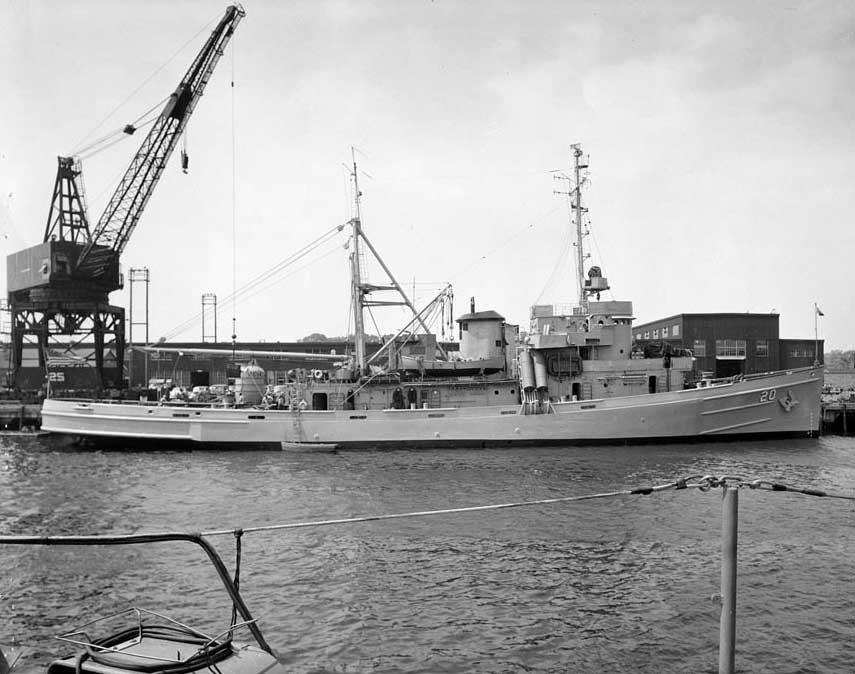
Yustaga
(ASR-20: dp. 1,735 (f.); 1. 205'0", b. 39'3"; dr. 16'6"
(lim.); s. 16 k.; cpl. 106; cl. Penguin)
Yustaga (ATF-165) was laid down in July 1945 at Charleston, S.C., by the Charleston Shipbuilding &Drydock Co.; redesignated a submarine rescue vessel on 11 October 1945; assigned the hull designation ASR-20 on 13 November 1945; renamed Skylark on 5 December 1945, launched on 19 March 1946, sponsored by Mrs. H. C. Weatherly; and was placed in the Atlantic Reserve Fleet, berthed first at Charleston and later at New London, Conn., until 1 March 1951 at which time she was finally commissioned, Lt. Comdr. Romolo Cousins in command.
Following restricted availability at the Portsmouth (N.H.) Naval Shipyard, Skylark conducted her shakedown cruise and training out of Norfolk, VA., during July. The ship then returned to New London and operated out of that base, practicing submarine rescues and serving as a target recovery ship for submarines conducting torpedo-firing drills. In April 1952, the ship temporarily moved south to relieve Petrel (ASR-14) as rescue vessel at Key West, Fla., while the latter ship underwent an overhaul. In June, she returned north to New London to resume her former duties. During January and February 1953, Skylark was overhauled at the Philadelphia Naval Shipyard; and, after refresher training at Newport, R.I., during March and April, she spent May at Norfolk filling in for Kittiwake (ASR-13) while the latter ship went into the shipyard for overhaul. In June, she returned to New London and carried out her training schedule until October when she again headed back to Norfolk to substitute for Kittiwake, while the latter participated in Operation "Springboard." Upon the conclusion of that brief assignment, she resumed her New London-based routine In February and March of 1954, Skylark engaged in her own share of Operation "Springboard" exercises,providing services to Atlantic Fleet submarines during the annual training evolution. She returned to New London late in March and resumed her usual duties. In September, the ship entered the Boston Naval Shipyard for a two-month overhaul.
Until the beginning of 1962, Skylark continued the pattern of duties described above. She operated out of New London the majority of the time but, periodically, did temporary duty elsewhere, notably at Norfolk and Key West, taking over briefly the duties of Kittiwake or Petrel when either ship was incapacitated due to repairs. She also operated regularly in the West Indies during the annual "Springboard" exercises. The one notable exception to that pattern occurred in January and February of 1955 when she assisted Nautilus (SSN-571), the Navy's first nuclear-powered submarine, in completing her builders' trials.
At the beginning of 1962, the submarine rescue vessel began a new phase of her career when regular deployments to the 6th Fleet in the Mediterranean became a normal aspect of her activities and continued to be for the remainder of her naval service. She embarked upon the first such cruise on 8 January 1962. During that assignment, she served as flagship of Task Force (TF) 69 and participated in the search for an Air Force jet fighter which crashed at sea near Malaya, Spain. On 7 May 1962, she returned to New London and resumed her duties with the Atlantic Fleet. In April of 1963, she was one of the first ships to answer the distress call sent by Thresher (SSN-593) before she sank during diving tests. Skylark also participated in the unsuccessful search for the submarine which was conducted for several days after the loss. In July 1963, she was deployed to the Mediterranean once more and again served as flagship of TF 69. That cruise lasted until late October, and Skylark reentered New London on 2 November. Nineteen months of duty out of her home port, along the Atlantic coast of the United States, followed her return home.
On 7 July 1965, the submarine rescue vessel stood out of New London once more, hound for the Mediterranean and duty in support of 6th Fleet submarines. During the latter portion of that cruise, Skylark served for several weeks at the ballistic missile submarine base located in Holy Loch, Scotland, before returning home to New London on 29 October. During the remaining eight years of her Navy career, the ship alternated duty along the Atlantic coast of the United States with deployments to the Mediterranean and to the submarine base at Holy Loch. In the spring of 1968, she participated in the unsuccessful rescue attempt and search for Scorpion (SSN-589), the second American nuclear-powered submarine to be lost at sea. Her only other major departure from her routine came in June of 1972 when she participated in NATO Exercise "Pink Lace" before beginning a scheduled deployment to Holy Loch and the Mediterranean in July. She returned to New London on 18 November 1972, completing the last deployment of her career. On 30 June 1973, Skylark was decommissioned, and her name was struck from the Navy list. On that same day she was sold to the Brazilian Navy and commissioner as Gastao Moutinho (K. 10). As of 1979, she was still an active unit of the Brazilian Fleet.
